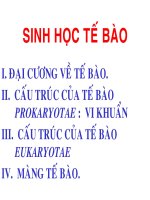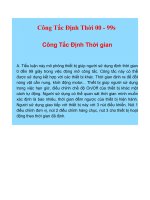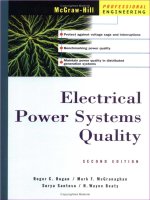D2726 00
Bạn đang xem bản rút gọn của tài liệu. Xem và tải ngay bản đầy đủ của tài liệu tại đây (21.87 KB, 4 trang )
Designation: D 2726 – 00
Standard Test Method for
Bulk Specific Gravity and Density of Non-Absorptive
Compacted Bituminous Mixtures1
This standard is issued under the fixed designation D 2726; the number immediately following the designation indicates the year of
original adoption or, in the case of revision, the year of last revision. A number in parentheses indicates the year of last reapproval. A
superscript epsilon (e) indicates an editorial change since the last revision or reapproval.
This standard has been approved for use by agencies of the Department of Defense.
1. Scope
1.1 This test method covers the determination of bulk
specific gravity and density of specimens of compacted bituminous mixtures.
1.2 This test method should not be used with samples that
contain open or interconnecting voids or absorb more than 2 %
of water by volume, or both, as determined in 10.4.
1.3 The values stated in SI units are to be regarded as the
standard. The values given in parentheses are for information
only.
1.4 This standard does not purport to address all of the
safety concerns, if any, associated with its use. It is the
responsibility of the user of this standard to establish appropriate safety and health practices and determine the applicability of regulatory limitations prior to use.
3. Terminology
3.1 Definitions of Terms Specific to This Standard:
3.1.1 bulk density—as determined by this test method, the
mass of a metre cubed (or foot cubed) of the material at 25°C
(77°F).
3.1.2 bulk specific gravity—as determined by this test
method, the ratio of the mass of a given volume of material at
25°C to the mass of an equal volume of water at the same
temperature.
4. Summary of Test Method
4.1 The specimen is immersed in a water bath at 25°C
(77°F). The mass under water is recorded, and the specimen is
taken out of the water, blotted quickly with a damp cloth towel,
and weighed in air. The difference between the two masses is
used to measure the mass of an equal volume of water at 25°C.
Correction factors are provided for converting the mass of
water to that of the reference 25°C if from a practical point of
view the weighing was done at different temperatures.
4.2 This test method provides guidance for determination of
the oven dry or thoroughly dry mass of the specimen. The bulk
specific gravity is calculated from these masses. Then the
density is obtained by multiplying the specific gravity of the
specimen by the density of the water.
2. Referenced Documents
2.1 ASTM Standards:
C 670 Practice for Preparing Precision and Bias Statements
for Test Methods for Construction Materials2
D 979 Practice for Sampling Bituminous Paving Mixtures3
D 1188 Test Method for Bulk Specific Gravity and Density
of Compacted Bituminous Mixtures Using Paraffin-Coated
Specimens3
D 1461 Test Method for Moisture or Volatile Distillates in
Bituminous Paving Mixtures3
D 3203 Test Method for Percent Air Voids in Compacted
Dense and Open Bituminous Paving Mixtures3
D 3666 Specification for Minimum Requirements for Agencies Testing and Inspecting Bituminous Paving Materials3
D 4753 Specification for Evaluating, Selecting, and Specifying Balances and Scales for Use in Testing Soil, Rock,
and Related Construction Materials4
5. Significance and Use
5.1 The results obtained from this test method can be used
to determine the unit weight of compacted dense bituminous
mixtures and in conjunction with Test Method D 3203, to
obtain percent air voids. These values in turn may be used in
determining the relative degree of compaction.
5.2 Since specific gravity has no units, it must be converted
to density in order to do calculations that require units. This
conversion is made by multiplying the specific gravity at a
given temperature by the density of water at the same temperature.
1
This test method is under the jurisdiction of ASTM Committee D04 on Road
and Paving Materials and is the direct responsibility of Subcommittee D04.21 on
Specific Gravity and Density of Bituminous Mixtures.
Current edition approved Aug. 10, 2000. Published September 2000. Originally
published as D 2726 – 68T. Last previous edition D 2726 – 96ae1.
2
Annual Book of ASTM Standards, Vol 04.02.
3
Annual Book of ASTM Standards, Vol 04.03.
4
Annual Book of ASTM Standards, Vol 04.08.
NOTE 1—The personnel and equipment used in performing this test can
be evaluated in accordance with Practice D 3666.
Copyright © ASTM, 100 Barr Harbor Drive, West Conshohocken, PA 19428-2959, United States.
1
D 2726
then determine the mass by weighing in water. Designate this
mass as C. If the temperature of the specimen differs from the
temperature of the water bath by more than 2°C (3.6°F), the
specimen shall be immersed in the water bath for 10 to 15 min,
instead of 3 to 5 min.
9.1.1.1 Measure the temperature of the water and if different
from 25 6 1°C (77 6 1.8°F) a correction to the bulk specific
gravity to 25°C must be made in accordance with 10.2.
9.1.2 Mass of Saturated Surface-Dry Specimen in Air—
Surface dry the specimen by blotting quickly with a damp cloth
towel and then determine the mass by weighing in air.
Designate this mass as B.
9.1.3 After determining the mass in water and in a saturatedsurface dry condition, thoroughly dry the specimen to a
constant mass at 110 6 5°C (230 6 9°F). Allow the specimen
to cool and weigh in air. Designate this mass as A. Other
methods may be used to dry the specimen as long as a constant
mass is achieved (mass repeats within 0.1 %).
6. Apparatus
6.1 Balance, with ample capacity, and with sufficient sensitivity to enable bulk specific gravities of the specimens to be
calculated to at least four significant figures, that is, to at least
three decimal places. It shall be equipped with a suitable
apparatus to permit weighing the specimen while suspended in
water. To avoid erroneous readings by undue displacement of
water, use wire or fish line of the smallest practical size to
suspend the specimen and holder. Do not use chains, strings, or
sash cords. The balance shall conform to Specification D 4753
as a Class GP2 balance.
NOTE 2—Since there are no more significant figures in the quotient
(bulk specific gravity) than appear in either the dividend (the mass of the
specimen in air) or in the divisor (the mass of the volume of water equal
to the volume of the specimen, obtained from the difference in weight of
the saturated surface-dry specimen in air and in water), this means that the
balance must have a sensitivity capable of providing both mass values to
at least four figures. For example, a sensitivity of 0.1 g would provide four
significant figures for mass in the range from 100.1 g to 999.9 g.
6.2 Water Bath, for immersing the specimen in water while
suspended, equipped with an overflow outlet for maintaining a
constant water level. The use of an overflow outlet is mandatory.
NOTE 3—Drying the specimen at the required temperature of 110°C
(230°F) will change the characteristics and shape of the specimen. This
will make the specimen unsuitable for further testing. Drying the
specimen at a reduced temperature such as 52°C (125°F), in order to keep
it intact, will not meet the requirements of this test method.
7. Sampling
7.1 Specimens may be either laboratory-molded bituminous
mixtures or from bituminous pavements.
7.2 Obtain field samples in accordance with Practice D 979.
7.3 Pavement specimens shall be taken from pavements
with a core drill, diamond or a carborundum saw, or by other
suitable means.
9.1.3.1 Microwave drying or other approved methods may
be used to dry the specimen if the specimen is not over-heated
and documentation exists showing that the results are equivalent to oven drying. The interval of time between readings to
determine constant mass must be sufficient to ensure that all
moisture and solvent has been removed. This interval is
dependent on the size of the specimen and can be determined
by experimentation and confirmed with the oven-dried comparisons. Documentation must exist to validate the intervals.
9.2 For Laboratory-Prepared Thoroughly Dry Specimens:
9.2.1 Mass of Dry Specimen in Air—Determine the mass by
weighing the specimen after it has been standing in air at room
temperature for at least 1 h. Designate this mass as A.
9.2.2 Mass of Specimen in Water—Use the same procedure
as described in 9.1.1.
9.2.3 Mass of Saturated Surface-Dry Specimen in Air—
Surface dry the specimen by blotting quickly with a damp cloth
towel and then determine the mass by weighing in air.
Designate this mass as B.
8. Test Specimens
8.1 Size of Specimens—It is recommended, (1) that the
diameter of cyclindrically molded or cored specimens, or the
length of the sides of sawed specimens, be at least equal to four
times the maximum size of the aggregate; and (2) that the
thickness of specimens be at least one and one half times the
maximum size of the aggregate.
8.2 Care shall be taken to avoid distortion, bending, or
cracking of specimens during and after removal from pavements or mold. Specimens shall be stored in a safe, cool place.
8.3 Specimens shall be free of foreign materials such as seal
coat, tack coat, foundation material, soil, paper, or foil. When
any of these materials are visually evident, they shall be
removed by sawing in accordance with 8.6.
8.4 If desired, specimens may be separated from other
pavement layers by sawing or other satisfactory means.
10. Calculation
10.1 Calculate the bulk specific gravity of the specimen as
follows:
Bulk sp gr 5 A/~B 2 C!
9. Procedure
9.1 For Cores and for Other Specimens that May Contain
Moisture or Solvent—Only specimens that are known to be
thoroughly dry (that is, laboratory-prepared dried specimens),
are to be tested in accordance with 9.2. All others are assumed
to contain moisture or solvent and are to be tested in accordance with 9.1. The sequence of testing for 9.1 is: in water,
saturated-surface dry, dry.
9.1.1 Mass of Specimen in Water—Completely submerge
the specimen in the water bath at 25°C (77°F) for 3 to 5 min
(1)
where:
A
= mass of the dry specimen in air, g,
(B − C) = mass of the volume of water for the volume of
the specimen at 25°C,
B
= mass of the saturated surface-dry specimen in air,
g, and
C
= mass of the specimen in water, g.
10.2 The bulk specific gravity of the specimen at 25°C can
be calculated from bulk specific gravity of the specimen
measured at any other temperature as follows:
2
D 2726
Bulk sp gr at 25°C 5 K 3 Bulk sp gr measured at any other
temperature
per foot cubed and the recording of density in pounds
force per foot cubed is acceptable with this test method.
(2)
where:
K = determined from Table 1.
10.2.1 This calculation is valid for the precision of the test
method if the temperature of the water differs from 25°C by
less than 3°C (5.4°F). For a difference of temperature greater
than 3°C (5.4°F), a correction to the mass of water displaced
shall be made using the following equation:
correction 5 DT 3 Ks 3 ~B 2 C!
11. Report
11.1 Report the following:
11.1.1 Bulk specific gravity of the mixture to the third
decimal place as: bulk specific gravity at 25°C,
11.1.2 Density of the mixture with four significant figures in
Kg/m3 or lb/ft3 as: density at 25°C,
11.1.3 Type of mixture,
11.1.4 Size of sample, and
11.1.5 Water absorption, %.
(3)
where:
DT = 25°C − the temperature of the water bath, and
Ks = 6 3 10−5 mL/mL/°C average coefficient of cubical
thermal expansion of bituminous concrete.
10.3 Calculate the density of the specimen as follows:
Density 5 Bulk sp gr 3 997.0 ~ or 62.24!
12. Precision and Bias
12.1 Criteria for judging the acceptability of bulk specific
gravity test results obtained by this test method are given in the
following table:5
(4)
Test and Type Index
Single operator precision
Multilaboratory precision
where:
997.0 = density of water in Kg/m3 at 25°C (0.9970 g/cm3)
10.4 Calculate the percent water absorbed by the specimen
(on volume basis) as follows:
B2A
Percent water absorbed by volume 5 B 2 C 3 100
(5)
12.2 The figures given in Column 2 are the standard
deviations that have been found to be appropriate for the
conditions of test described in Column 1. The figures given in
Column 3 are the limits that should not be exceeded by the
difference between the results of two properly conducted tests.
12.3 The values in Column 3 are the acceptable range for
two tests. When more than two results are being evaluated, the
range given in Column 3 must be increased. Multiply the
standard deviation(s) in Column 2 by the multiplier given in
Practice C 670, Table 1, for the number of actual tests.
Example: for three tests − 0.0124 3 3.3 = 0.041. Additional
guidance and background is given in Practice C 670.
12.4 Bias—Since there is no accepted reference material
suitable for determining the bias for the procedure for measuring density, no statement on the bias of this test method is
being made.
TABLE 1 Absolute Density of Water and Conversion Factor K for
Various Temperatures
Absolute Density of
WaterA
Correction Factor K
10
11
12
13
14
15
16
17
18
19
20
21
22
23
24
25
26
27
28
29
30
0.999728
0.999634
0.999526
0.999406
0.999273
0.999129
0.998972
0.998804
0.998625
0.998435
0.998234
0.998022
0.997801
0.997569
0.997327
0.997075
0.996814
0.996544
0.996264
0.995976
0.995678
1.002661
1.002567
1.002458
1.002338
1.002204
1.002060
1.001903
1.001734
1.001555
1.001364
1.001162
1.000950
1.000728
1.000495
1.000253
1.000000
0.999738
0.999467
0.999187
0.998898
0.998599
Acceptable Range of Two
Results (D 2S)
0.035
0.076
NOTE 4—Samples for the interlaboratory study were prepared in three
bituminous mixing plants and were compacted by the individual laboratories with Marshall compaction equipment using 75 blows each end of
the specimen. Mechanical compactors were also used, but they were
calibrated to give compaction equivalents for the 75 blows of the manual
equipment.
In a report6 dated March 22, 1988, The University of Nevada-Reno
concluded that “The ASTM D2726 precision statement accurately reflects
variances caused by either method of compaction (Marshall or Hveem), or
by aggregate type (rounded or angular).”
10.5 If the percent water absorbed by the specimen in 10.4
exceeds 2 %, use Test Method D 1188.
10.6 This test method has been written using the absolute
system for density (kilograms per metre cubed) in SI units. The
conversion to the gravitational system of unit weight in pounds
Temperature,° C
Standard Deviation
(1S)
0.0124
0.0269
13. Keywords
13.1 air voids; compaction; density; specific gravity; unit
weight
5
A
Data taken from Handbook of Chemistry and Physics, 55th ed., CRC Press,
Inc.
6
3
Basis of estimate: 4 replicates, 6 materials, 16 laboratories.
Supporting data available from ASTM headquarters. Request RR: 1004.
D 2726
The American Society for Testing and Materials takes no position respecting the validity of any patent rights asserted in connection
with any item mentioned in this standard. Users of this standard are expressly advised that determination of the validity of any such
patent rights, and the risk of infringement of such rights, are entirely their own responsibility.
This standard is subject to revision at any time by the responsible technical committee and must be reviewed every five years and
if not revised, either reapproved or withdrawn. Your comments are invited either for revision of this standard or for additional standards
and should be addressed to ASTM Headquarters. Your comments will receive careful consideration at a meeting of the responsible
technical committee, which you may attend. If you feel that your comments have not received a fair hearing you should make your
views known to the ASTM Committee on Standards, at the address shown below.
This standard is copyrighted by ASTM, 100 Barr Harbor Drive, PO Box C700, West Conshohocken, PA 19428-2959, United States.
Individual reprints (single or multiple copies) of this standard may be obtained by contacting ASTM at the above address or at
610-832-9585 (phone), 610-832-9555 (fax), or (e-mail); or through the ASTM website (www.astm.org).
4









